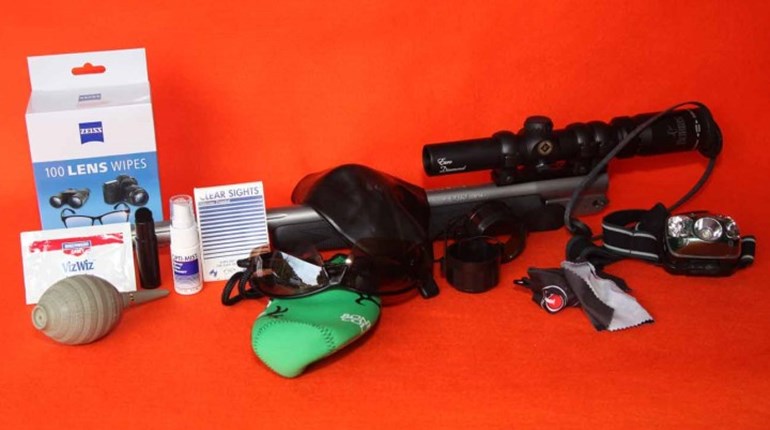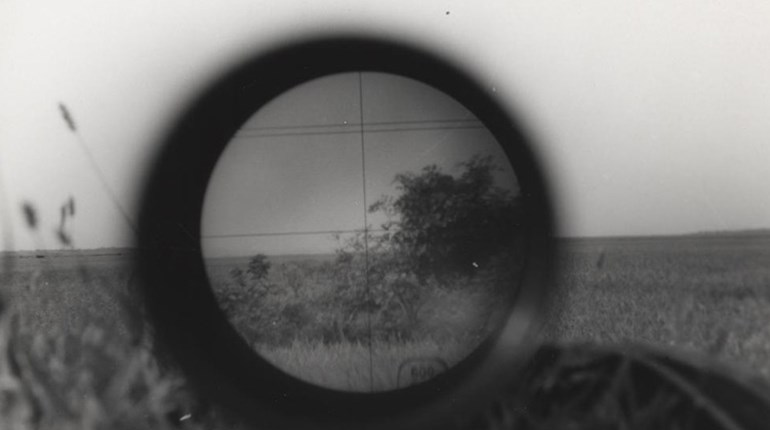
A Porro-prism 7x35mm binocular with a stippled, black leather covering was the standard when I was a budding nimrod in the 1960s. But it’s been replaced by the ubiquitous green, armor-covered, roof-prism 8x42 or 10x42mm instrument, and the view is better than ever. One peek through a Konus Emperor reveals that.
Konus isn’t the name of an ancient Roman god, but a company, started in 1979, headquartered in Verona, Italy, with U.S. headquarters in Miami. I’d never used a Konus optic until testing this $229 Emperor—Konus’ top-of-the-line binocular—but I was surprised by its performance.
There seem to be so many companies selling binoculars these days that one can hardly keep abreast. I’ve generally ignored new brands due to inertia and bias. I assumed new companies with strange names were hustling cheap products. While there are a few (order before midnight and get a second pair free!), Konus is not one of them. This Emperor, built in the People’s Republic of China (P.R.C. on the box) looks and feels solid, operates smoothly and can hold its own with binoculars in a much higher price bracket. Here’s why:
The Konus folks seem to understand the essential role anti-reflection lenses play in light transmission, high contrast and usable brightness. Every air-to-glass surface in the Emperor is, reportedly, fully multi-coated. That means maximum light passes through, leaving few photons to bounce around and create distracting flare. I saw this as I glassed toward the setting sun. While flare control wasn’t complete, as in the Swarovski EL tested alongside, it was good. A less expensive Redfield Rebel ($150) however, did slightly better. Contrast and color saturation was better in the Konus than the Rebel, but after sunset images through the Konus showed a strong yellow cast, an indication of excessive lead or titanium in the lenses.
Image sharpness, or resolution, is a product of the very first lens that light passes through, called the objective lens. All internal lenses must be perfect, too, but if the objective lens doesn’t transmit an undistorted image, nothing will improve it. The average buyer can’t measure an objective lens’ precision, but he can check resolution by comparison. One can set out a target of half-inch-wide black-and-white bars at 100 yards and count them. The naked human eye with 20/20 vision can resolve a 3.5-inch-tall object at 100 yards, so a binocular with 10X magnification should do 10 times better. Try it. I usually just try to read newsprint in low light anywhere from 20 to 30 yards and compare a test binocular against a known standard, in this case a Swarovski EL 10x42. This is a good tactic for comparing binoculars when shopping. Pit the winner against all comers until you’ve winnowed out the champ. Of course the $1,200 Swarovski blew the Konus out of the water, but not as far onto dry land as I’d have guessed. Five minutes after sunset I could already see the Austrian bino was brighter. At 50 minutes after sunset I could no longer read half-inch-high white letters on a red background with the Konus from 25 yards. The Rebel gave me another two minutes and the Swarovski stretched another nine minutes.
Roof prisms distort light waves by splitting them. This is called “phase distortion.” The Emperor fights this by using BAK-4 prism glass, the best for roof prisms, and secondly by phase-coating them. This magical coating eliminates phase distortion. Without it a roof prism is difficult to build with sharpness as good as that of a less-expensive Porro prism. I didn’t expect to find it on an inexpensive binocular such as the Emperor, but it was there.
The W.A. designation on this binocular stands for Wide Angle. The Konus website lists the unit’s field of view as 315 feet at 1,000 yards. (For some reason, it’s also listed on the binocular, but as 294 feet.) The Swarovski EL 10x42 covers 336 feet, the Nikon Premier 314 feet, Vortex Viper 319 feet and Steiner Predator C5 315 feet, and none of those claim to be “wide angle.” Regardless, I attach minimal value to extreme wide-angle coverage because the human eye/brain focuses its attention on the small center of the view. At best you might catch the flicker of motion at the extreme edges.
This same center-focus minimizes the value of edge sharpness to a significant degree. We move the binocular to study new terrain in the center of our view rather than move our eyes around within the binocular’s view, so edge sharpness is not critical unless it encroaches too far into the middle of the lens. The Emperor’s did not. Sharpness fell off beginning in roughly the last 25 percent of the circle, about the same as that of the Redfield Rebel and slightly more than a Steiner Predator C5. A Swarovski EL remained nearly perfectly sharp right to the edge.
Unlike most inexpensive binoculars, the Emperor includes twist-up eyecups that not only lock in the fully extended position, but hold pretty firmly at intermediate settings. The “3+/-” diopter adjustment is made with the familiar knurled ring around the base of the right eyepiece. It’s hard to turn, but once set it’ll stay put. Ergonomically the instrument is so small that even my relatively small hands nearly cover the barrels, end to end. There are no padded or contoured thumb rests, but my thumbs naturally fell just under the eyepieces behind two ribs for a good grip. The single, 2-inch-long center hinge bridge provided the perfect location for my center two fingers with a raised rib under each. There is a screw cap on the end of the hinge that removes to expose an attachment point for a tripod mount, a nice bonus.
As expected, this unit is nitrogen-filled and guaranteed waterproof. An hour under water proved this. Turning focus ring, diopter ring, eyecups and swinging the hinge while submerged didn’t pump in any water. One-piece, soft rubber eyepiece lens covers fit snugly. However, the rubber rings for attaching the objective covers practically fell off before I fitted them. Tape or glue them if you want to keep them. The attachment points for the neck strap on the back of the barrels result in the tops of the instrument tipping away from the body. Konus would be wise to change to side mounts.
All in all, it might sound like I’m being critical of the Emperor, but that’s because I compared it to a $1,200 Swarovski. That’s like comparing a Honda to a Mercedes. The Honda is plenty good enough for most of us. If you’d told me five years ago I’d give a thumbs-up to a roof-prism binocular costing less than $300, I’d have slapped you silly. Glad you didn’t, because I’d have to beg your forgiveness now. The Konus Emperor is surprisingly good for the money.
Specs:
www.konus.com
Type: roof-prism binocular
Magnification: 10x (tested); 8x
Objective Lens Diameter: 42mm
Exit Pupil: 4.2mm
Focusing Range: 10' to infinity
Twilight Factor: 17.6
FOV @ 1,000 yards: 294'
Weight: 22.1 ozs.
Dimensions: 5" wide, 5" high
Coatings: fully multi-coated lenses, phase-coated prisms
Construction: aluminum chassis; ribbed, green armor coating
Accessories: neck strap, nylon case, eyepiece lens covers, objective lens covers
MSRP: $229.99




































